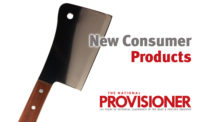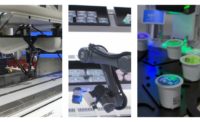Advanced Automation, Inspired Innovation
By Bryan Salvage, Editorial Director
Technology for making and slicing bacon becomes more sophisticated to meet ever-changing customer demands.
When it comes to in-plant technology used to satisfy evolving customer needs for sliced bacon – one of the most beloved and consumed meat products in the United States, processors can choose from a wide range of options. Multiple options are important because bacon, which comes in a multitude of shapes, sizes, and flavors these days, continues to be B-I-G business. For instance, sales for retail bacon alone for calendar year 2004 were $2,132,690,304 – up 5.2 percent from year-earlier sales, relays Information Resources Inc., Chicago, IL, and bacon usage in many foodservice segments continues to grow and further diversify.
Despite varying equipment demands, at the very top of the must have list for all bacon processors is technology that helps to improve yields.
“We’re continuously looking at ways to improve yields through automation, and that will always be a challenge our customers place upon us,” says Chris Mason, president and chief executive officer of AEW Delford Systems, Lake Zurich, IL. “Minimizing labor is also a key issue.” AEW Delford Systems offers automatic portion-control slicing, sawing, shaping, checkweighing, grading, weigh-price labeling, wrapping, sleeving, and robot portion loading technology – either as stand-alone machines or fully-integrated systems.
Bacon processors want a system that’s smart enough to make decisions on its own, as well as control yield while minimizing labor on a particular line, Mason says.
“Yield, of course, where bacon is more than one dollar a pound, is very important. The savings that can be made in terms of payback all of a sudden makes such technology a very viable solution,” he adds.
New and innovative technology continues driving the bacon industry forward. Following the introduction of AEW’s new IBS2000 Vision slicer last year, one customer was more than impressed with this new entry.
“The IBS2000 Vision slicer is the best thing that’s happened to the U.S. bacon industry in forty years,” said Tim Simskey, vice president of operations, Farmer John, Vernon, CA. Most recently, another major bacon processor – Farmland Foods – voiced its approval of this slicer. As the fifth-largest retail refrigerated bacon processor in the United States, Farmland was in need of a bacon-slicing solution at its Crete, NE, processing plant. This facility manufactures a variety of bacon brands including Farmland, Carando, Roegelein, and Ohse, as well as private-label bacon for retail and foodservice customers. After reviewing its technology options, Farmland chose the IBS2000 Vision Slicer, which has now been in operation in its Crete plant since May 16, 2005.
“Farmland is always looking for new industry technology to improve products for our customers,” explains Todd Gerken, manager of Farmland’s Crete, NE plant.
More on the IBS2000
The IBS2000 Vision Slicer is an advanced, high-volume slicer for bacon and other whole-muscle products. Its patented Vision system yields unrivaled performance, especially for irregularly-shaped or partly-pressed product, Mason relays. The continuous feed version of this machine offers increased throughput for high-volume processors. The angled product bed combined with twin-jump conveyor gives accurate stacks and shingles at high speed.
Here’s how the IBS2000 works. The system uses a high-speed camera to scan the leading face of the product before slicing. Next, it measures the area and the fat/lean ratio and adjusts the thickness of the next slice. This minimizes giveaway while maximizing on-weight percentages, resulting in the best-possible yield and throughput. What’s more, the IBS2000 Vision Slicer can be integrated into automotive lines for fixed-weight retail and bulk packing. It can operate as a stand-alone machine or it can be integrated with a range of manual or automatic production lines.
Technology suppliers abound. Why did Farmland ultimately turn to AEW Delford? “Because of AEW’s overall reliability, as well as their equipments’ cleanability and worker-safety features,” Gerken answers. “The equipment performs day after day, repair costs are minimal, and the service is exceptional.
“Service ranks up there in the top-three reasons ‘to buy’ in the decision-making tree,” Gerken says. “When we brought the new line in, AEW’s Adrian Neave, technical services engineer, and Kirk Luchman, regional sales manager, sat down with me and said ‘We will not leave your plant until you are satisfied.’ They lived up to that promise. I was tremendously happy with the installation. If we had a problem or didn’t understand something, we’d get on the phone and call Adrian --- and he was right there. I’m very pleased with the support AEW Delford Systems has given us in all aspects.”
Providing extraordinary service is vital in developing partnerships with processors. “We would like to think that we develop machines, but actually we turn our customers’ ideas into reality,” Mason says. “At the end of the day, we and our customers are serving our customers’ customers --- and that’s really what it’s all about.”
Tying into this philosophy is AEW Delford’s choice of control systems.
“We’ve chosen control systems in our equipment that are off-the-shelf, in general, so our customers are not locked into only us being able to support them,” Mason explains. “While that limits our income stream, it opens up avenues of support for them that are even beyond our organization. That has met with a lot of strength and good reception from the industry.”
When asked what features he likes best about the IBS2000 Vision Slicer, Gerken responds: “The consistent slice thickness, and the ability of the checkweigher to dial in your weights and the slicing speed. Our operators think it’s great.”
Another selling point for Gerken was AEW’s willingness to modify this system based on Farmland’s specific slicing needs. “We made a few suggestions after we tested this system, and they implemented our design ideas to make the system easier to clean,” Gerken says.
The IBS2000 allows a customer to make accurate predictions on slice thickness for each and every slice made. Each slice will vary minutely in thickness, Mason says.
“We end up with a pack that is not only with a fixed slice count and weight, but also a very good pack presentation,” he continues. “Varying slice thickness is something most of our customers have pointed out as being a key feature. I didn’t think that varying slice thickness was a beneficial thing to do upfront, but once a customer sees the pack they’re amazed.”
Another system feature that is a unique point of difference is its ability to grade. “The costs of raw materials are going up so the value of first-grade products is also escalating,” Mason says. “This system has the ability to automatically determine the grade of product we are slicing. Therefore, the frequency of grade-one product being put into grade-two packs is minimized to a very low level. This adds value to the customer who’s using this equipment.”
Robotic portion loading
Robotic systems have long been valued in the meat industry to assist in a wide range of chores from palletizing to high-speed slicing. Proponents point out that robotic benefits also vary and include enhanced hygiene, more consistent process performance, better-quality products, and less labor, just to mention a few. AEW Delford’s IPL (Intelligent Portion Loading) robot system is a new innovation for bacon processing. “We have been working with ABB, a robotic specialist from Sweden, for about eighteen months now,” Mason says, “and we’ve developed a system that allows us to grip the shingled drafts of bacon or stacks of back bacon, which allows us to load these packages into a thermoforming machine. It also allows us to load portions into trays because it has its own vision system and is able to spot the center of gravity of a pack and then orient that pack correctly to fit the packaging machine being used. It gives us a very flexible solution, which can be simply programmed to do a different job with a different product from one day to the next.”
The IPL Robot will pick single, fresh or frozen, bone-in or boneless, meat portions or sliced groups – including bacon, coked meats, fish, and cheese – from a portioner, slicer, saw, or conveyor, and place them straight into trays or thermoformers ready for packing. Vision technology accurately recognizes the position and orientation of portions on the conveyor. This, in turn, enables the machine’s unique, mechanical action gripper to gently but quickly lift, transfer, and place the portioned product with great accuracy into the tray or thermoformer. High levels of hygiene are achieved, and the smooth, consistent gripper movement minimizes the risk of product damage. This enhances production continuity and provides an excellent presentation.
The IPL Robot also has the ability to identify incorrectly sized or misshapen portions and places them as required – or allows them to pass down the line for further grading. The system also has the ability to regulate product quality and specification by assessing fat content levels through the portion’s size and shape.
In Europe, the number of operational IPL Robot systems is growing quite quickly and for a wide variety of applications, too. The company plans to deliver a demonstration unit to the United States later this year.
Unique pickle injector
Another critical segment in bacon processing is the pickling process. Jack Kish, bacon specialist for Townsend Engineering Co., Des Moines, IA, says bacon-processor customers are demanding pickle mixing equipment that offers better control of formulation weights/measures, as well as more thorough mixing without air incorporation. Also, to meet the demands of greater control over the injection process, the company developed the Townsend 8000 AUTOinjector.
Features of this equipment include:
Operator controls with lead-through menus in both English and Spanish
Integrated weight platform with data capture and management reports
Simple, intuitive adjustments for injection percent
Low standard deviation of injection percent
Even distribution of curing ingredients
Low pickle recirculation and low pickle loss
Product recipes stored in the injector
Positive filtering – changeover without disrupting production
Self diagnostics for monitoring process and troubleshooting
Built in clean-in-place (CIP) cleaning cycle
End of the day cleaning disassembly – no tools required
Few consumables
Training aids (manuals/DVDs) technical service, and bacon processing information
Eye to the future
Bacon processing is moving up the ladder on the scale of importance for processors, Kish says.
“Since demand continues to increase and raw materials are more pricey, less variation needs to be built into the total bacon process to enhance profitability,” he adds.
Eating habits and dietary regimes will also continue to play a role in the evolution of retail and foodservice bacon, Mason contends.
“What we’re seeing is what happened in Europe … where slice and portion weights were driven downwards,” he says. “As products go up in prices, the pack size goes down. That, in itself, will mean that people need to process more packs per minute of a lower weight to achieve the same throughput they’re currently producing through their facilities. The technology needs to be fast enough to allow to maintain those capacities when such situations occur.” NP
Technology providers participating in this report include:
AEW Delford Systems, phone (847) 726-8000 or (800) AEW-SAWS, e-mail chicago@aewdelford.com, or visit www.aewdelford.com
Townsend Engineering Co., phone (515) 265-8181 or (800) 247-8609, e-mail info@TownsendEng.com, or visit www.TownsendEng.com




Report Abusive Comment